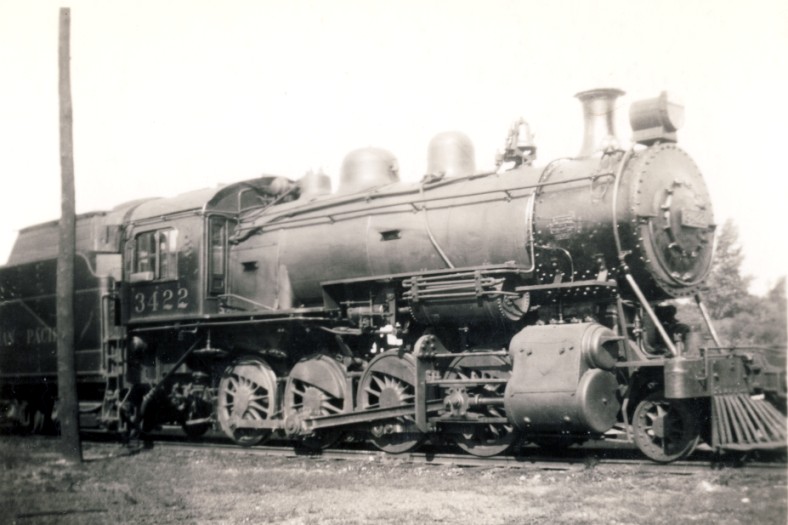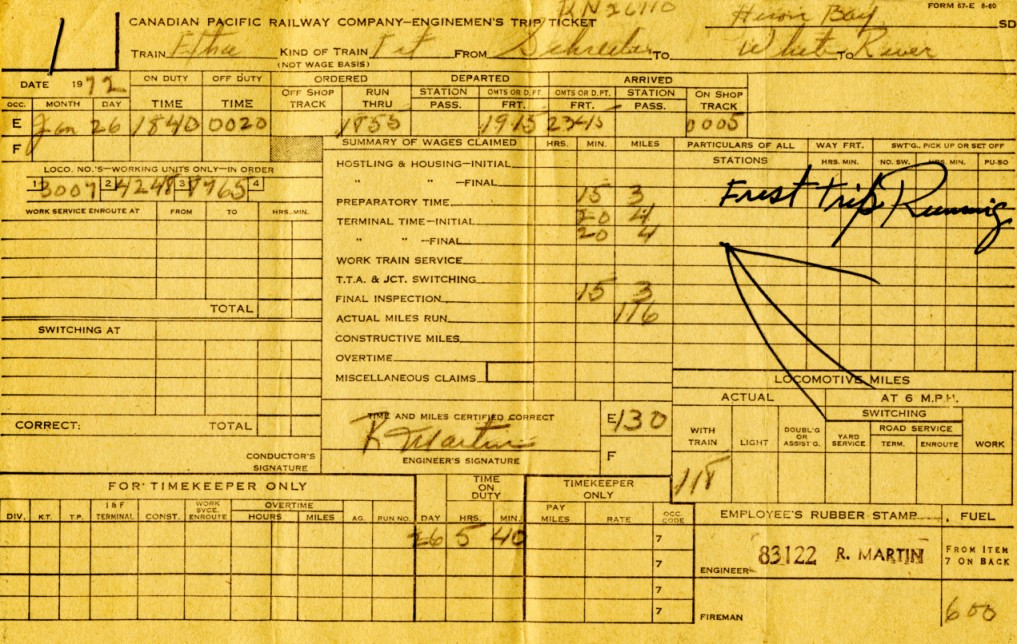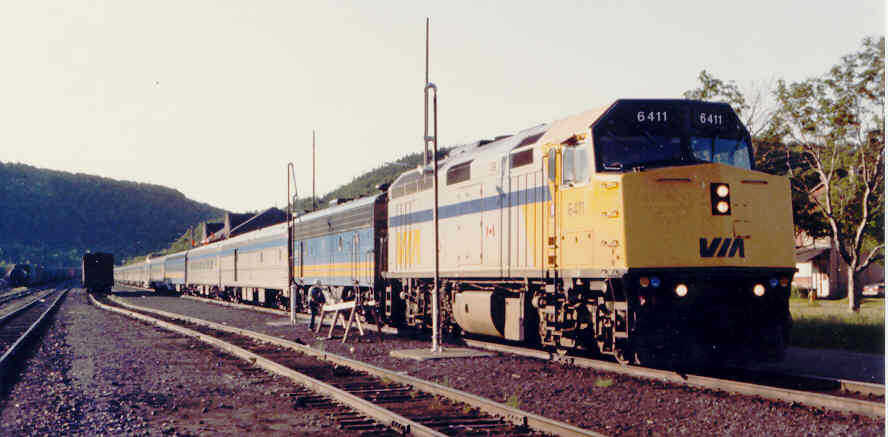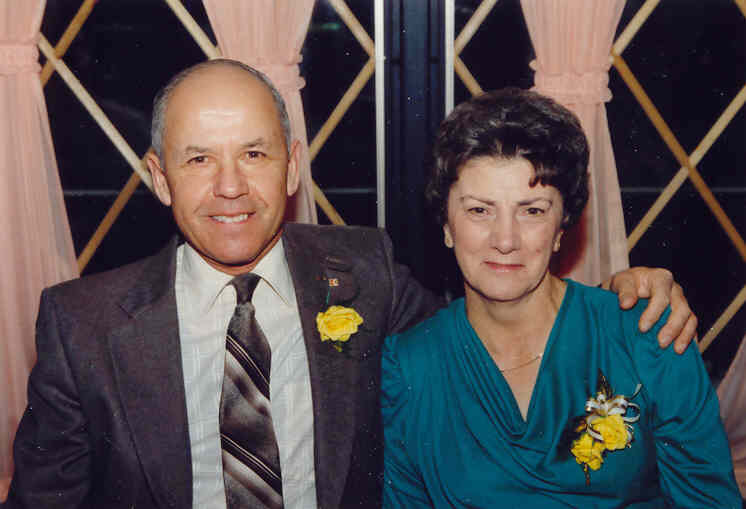Rolly
Martin
1928 -
2006
Originally from
St-Modeste near Rivière-du-Loup, Rolly came to Northern Ontario
as a young man. He first worked as a sectionman on the CPR at
Aubrey (near Biscotasing), Sudbury and Cartier. During this time
he also worked briefly for the Algoma Central Railway in the
same capacity.
 Rolly is shown on this bulletin to be the permanent sectionman
at Hawk Junction.
Rolly is shown on this bulletin to be the permanent sectionman
at Hawk Junction.
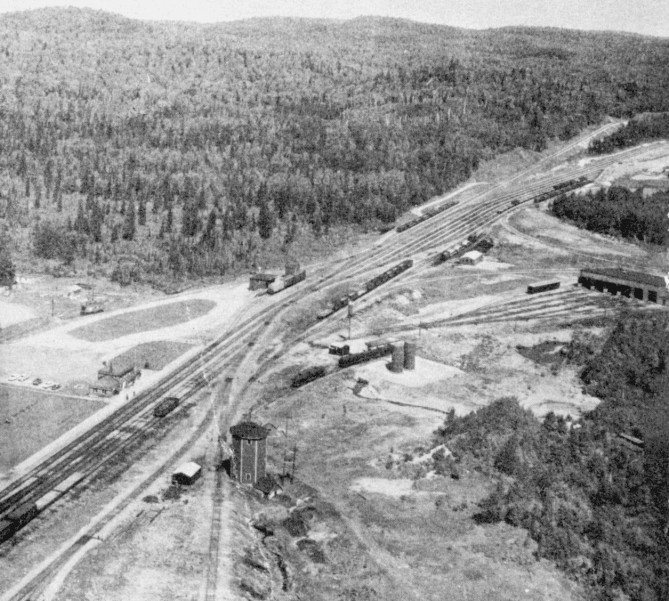
Hawk Junction - 'timetable north' is to the right.
The track at the left corner leads south to Sault Ste Marie.
The Michipicoten Subdivision to Lake Superior climbs away from
the mainline at the top right.
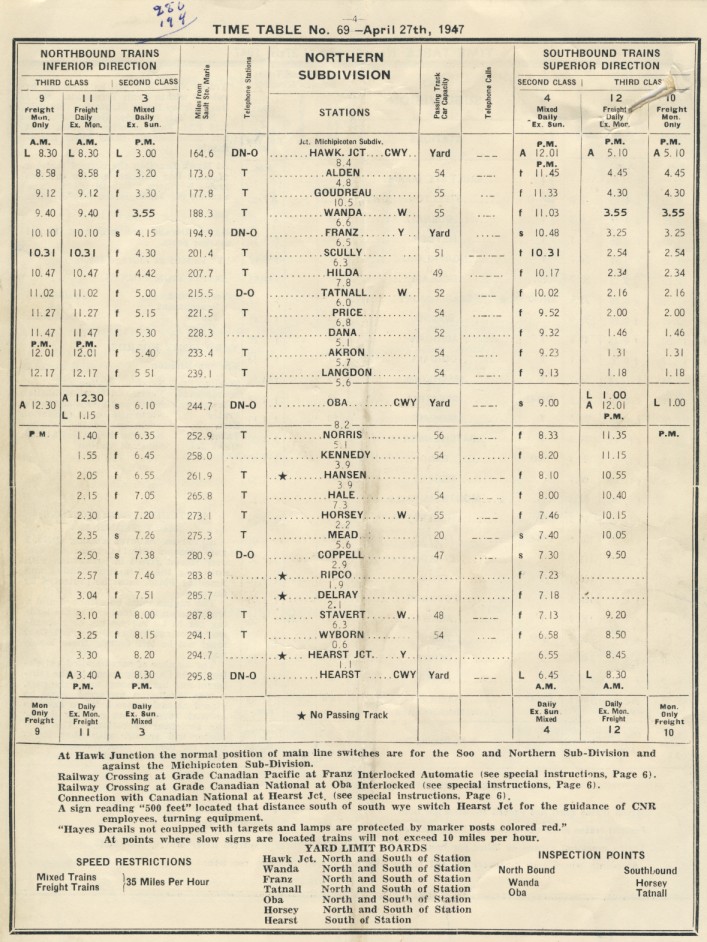
Rolly's timetable of the line north from Hawk Junction.
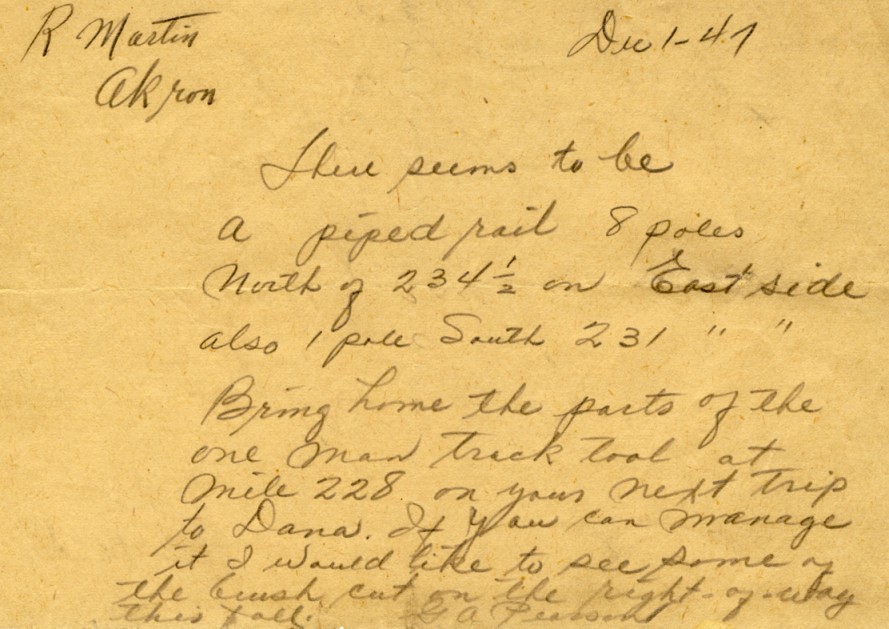
At
prescribed intervals - often weekly or more frequently - the
roadmaster travelled over 'his' entire track.
Any defects noted were documented, and slow orders were issued
for trains, if necessary, until repairs could be made.
Here, Rolly has received a note to attend to two defective
rails.
The locations are given by railway mileboard, fractions of
miles, then 'telegraph poles' for greater precision.
Piped rail, the long version:
If a steel ingot cools such that a cavity or depression forms
in it ...
and this flaw is passed on to the rails which are rolled from
it
...
a lengthwise crack can form along the vertical portion of the
rail's ' I ' shape over time ...
where the molecules of the smooth ingot surface were pressed
together ...
but failed to integrate with each other into the steel
material's solid structure.
(You fold over bread dough or Silly Putty, but don't mash it
to get rid of the folded-in outside surface)
Piped rail short
version:
A piped rail has a longitudinal web fissure ... which, when
inspected, will reveal a glossy-faced internal fault.
How would you do it ?
Using an old 'pump' handcar and applied physics, Rolly changed
a rail
(probably about 800 pounds)
on the Michipicoten Sub without assistance.
Assume you will not bring the defective rail back with you.
On to Schreiber
Rolly then moved to Schreiber, working as a classified
labourer
and ashpitman at the busy 22 stall roundhouse there. In these
occupations, he would gain the experience of working on
steam
locomotives.
This would include :
- Working as a locomotive 'wiper' (cleaning).
- Refilling the tender with coal and water, and
refilling the locomotive's sand dome.
- Cleaning
ash from the firebox after a locomotive came in after a run,
and
loading the waste into hopper cars for disposal - a dirty
job.
- Helping skilled staff with minor repairs requiring
brute strength, or a second, third, fourth pair of hands.
- Banking
and tending the fires of 'idling' steam locomotives as they
sat on the 'ready
track'. Draining a locomotive so it could just sit around
outside and
'freeze' was probably avoided because of all the pipes,
valves and
welded components which would not drain well and could be
damaged by ice expansion.
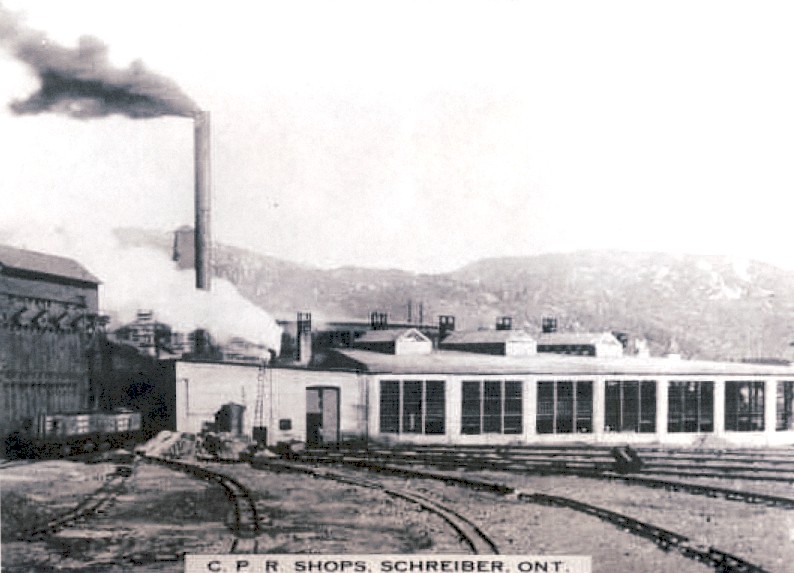
Schreiber in the late 1930s.
It seems they had an elaborate ash handling system with carts
and tracks.
There is lots of coal smoke ...
to produce the steam being used for shop power and to pipe
into the equipment, if needed.
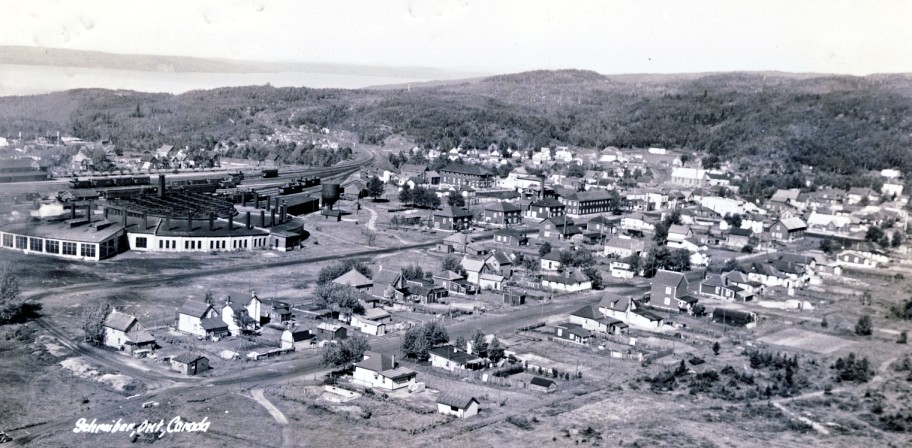
Schreiber, including an enclosed roundhouse turntable in the
late 1930s.
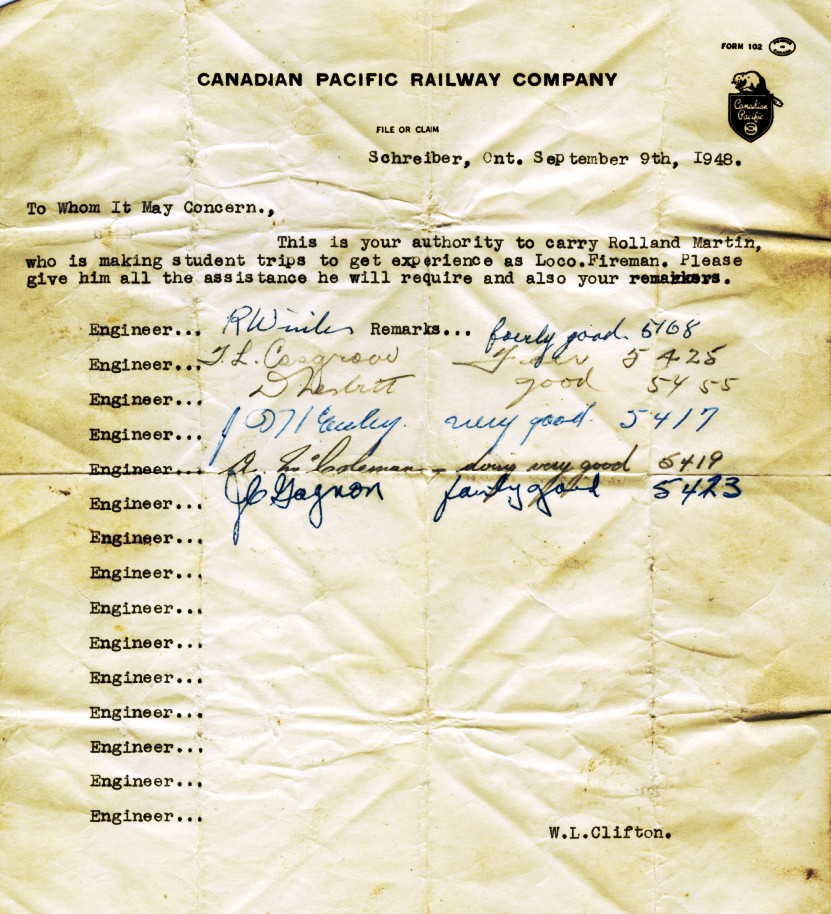
Rolly's record of unpaid fireman 'trial trips' ...
for experience in the engines as they travelled over the Heron
Bay and Nipigon Subdivisions.
(I never did meet engineer J.C. Gagnon while I was briefly
working in Schreiber)
The paid firemen would show him the work and the engineers
would grade him on attributes such as ...
Alertness and attention to signals and safety.
Knowledge of rules and locomotive procedures.
Cab neatness, e.g. keeping the deck clear of loose coal.
Physical capacity to shovel tons of coal per run, and to
refill the tender from a water tank.
Most important: Thinking
ahead ...
to always ensure enough heat and steam pressure was built up
by the time the engineer needed it.
For example, having everything very hot before climbing a long
grade.
There is a lag between throwing more coal in ...
injecting more water (even from a feedwater heater) ...
and finally getting more steam.
But if you are making too
much steam and are not using it up ...
... the safety valves would lift with a continuous thunderous
roar until the danger of a boiler explosion was relieved.
Would you throw a scoop of coal out the cab door onto the
right of way?
You are being just as wasteful when the 'pops' lift and the
steam is wasted!
To make things interesting for the student fireman ...
Different engineers often had different expectations and
different standards.
Working as a Fireman
Rolly qualified as a fireman, making his first run on
Thursday, September 2, 1948 on CPR engine 3422, a 2-8-0 built by
Alco
in Schenectady in October 1904.
CPR 3422, twenty years before Rolly's first paid trip.
Shown as a freight engine
in the 1930s, before its conversion to a switcher.
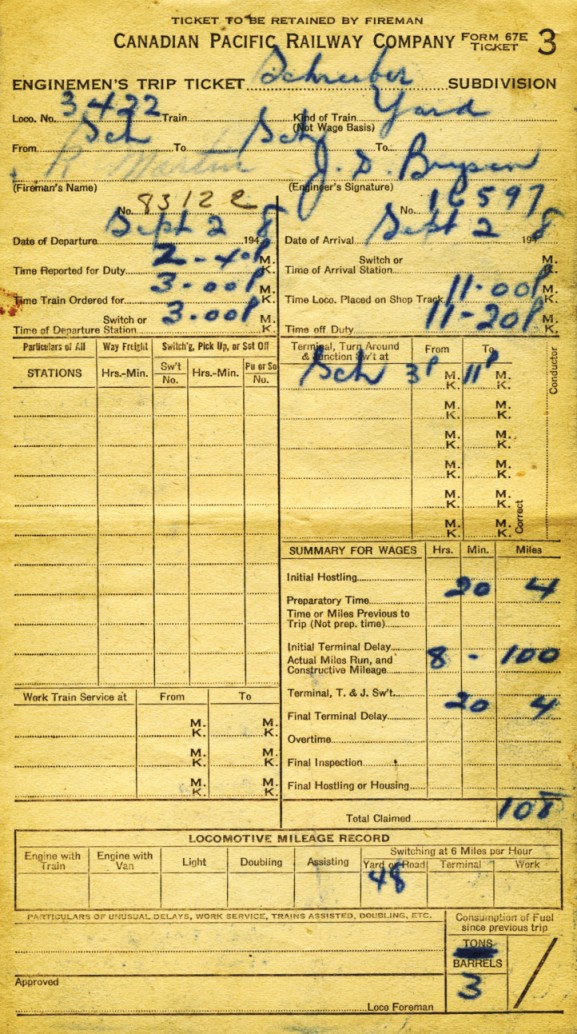
Rolly reported for work at 1440hr, had his 20 minutes (= 4
miles' pay) prep time and the locomotive was on duty at 15hr.
Notice that the fireman shovels about 3 tons of coal in an 8
hour switching shift.
Engineer Bryson was at the throttle as the crew performed the
regular Schreiber yard assignment.
Back then, besides switching freight cars for various
destinations,
this work would likely also include changing conductors' vans
on freight trains ...
before the age of 'pooled run-through cabooses' which stayed
attached to the through trains.
For the standard 8 hours (100 miles' pay) they worked until
23hr.
Then, another 20 minutes paid to tidy up as the Schreiber
locomotive shop took the locomotive back,
or the next switcher shift took over the engine and its
work assignment.
The minute to mile equivalents come from the Collective
Agreement.
This
'ticket' was Rolly's receipt ... and the conductor would
submit the
paperwork for the crew's pay to the Schreiber yard office.
Upstairs within the Schreiber station, the Division staff
would prepare, and issue the payroll cheques on payday.
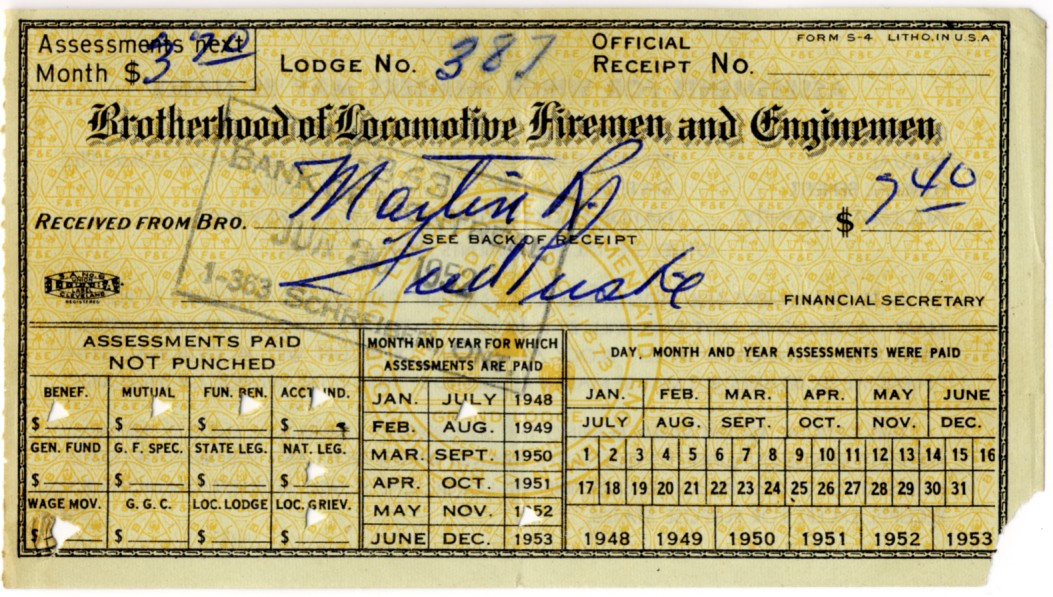
A receipt for Rolly's union dues.
It was also in 1953 that he was married, and shortly thereafter
he brought his wife Thérèse to Schreiber. While most families in
our society are usually together at the same time each day, the
families of most running trades employees experienced a much
different type of
life. They seldom knew when the telephone would ring - and their
loved
ones would once again be called to work at any hour of the day
or night.
During his career, Rolly worked on locomotives representing over
85 years of technological change. Just after beginning his
running trades career as fireman, Rolly witnessed the arrival of
the first diesels on the Schreiber Division in 1951. This was
one of the many changes Rolly was to experience over the course
of his long career.
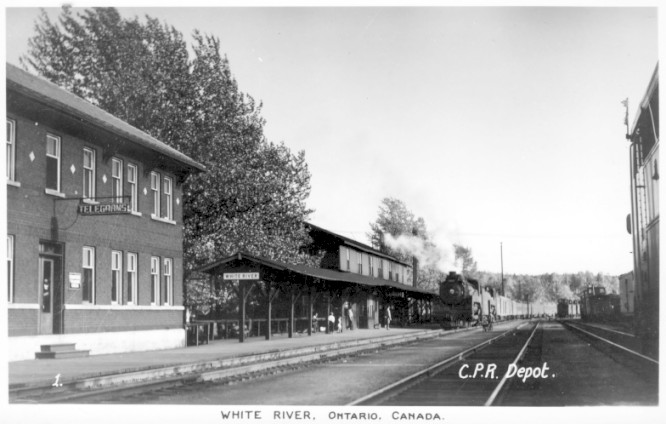
Rolly's
eastern terminal was White River - shown here in the 1950s.
Westbound doubleheaded steam and a new diesel freight
locomotive warily eye each other in front of the terminal.
The changes Rolly experienced included ...
- Train order and timetable, to automatic block
signals, to computerized centralized traffic control
systems.
- Introduction of end to end and train to wayside
radio communication.
- Electricity replacing kerosene in lanterns and
markers.
- The end of steam and full dieselization of the
division.
- The Canadian
- trains Number 1 and Number 2.
- The introduction of computerized train consists and
train profiles.
- The reduction or elimination of firemen, section
gangs, operators and tailend trainmen.
- Roller bearings replacing plain bearings.
- Ribbon rail replacing 39 foot bolted rail sections.
- The ability to operate mile long trains and
trains of 10,000 or more tons.
- Wayside "talking" hotbox detectors.
- Company managers who were recent university
graduates replacing "up through the ranks" managers who had
experienced the realities of running trades work.
- The installation of event recorders in all
locomotives.
- The elimination of vans.
- The discontinuance of through passenger service on
the Schreiber Division after more than 103 years.
However, some things
about railroading along the rugged granite shores of Lake
Superior have not changed over the years ...
- Temperatures of minus 40 and severe blizzards.
- Rock slides with some boulders the size of
automobiles occupying the track just beyond a blind curve.
- Washouts and tracks flooded by the waters of Lake
Superior.
- Staying awake and alert after long days on duty with
only a few hours of sleep in between.
- Rails broken by the cold.
- Days so cold it is not possible to get air through a
train.
- Locomotives shutting down at the worst possible
moment.
- Sitting in a siding for hours.
- Derailments stranding crews away from home for days
at a time.
- Broken coupler knuckles and drawbars in the middle
of a cold winter night.
- Signals obscured by blizzards and thick fog.
- The
trauma of striking and killing trespassers, or motorists who
were
careless at a level crossing. Seeing the actual carnage and
talking to
police as the public gathered. Being unable to eat for
a week,
and preserving the yellowed newspaper clipping forever. (In
recent
years, railways have finally provided counselling - usually
at the next
terminal)
- The possibility, through no fault of your own, of
suddenly
seeing a train approaching on your track with a combined
closing speed
of 80mph.
- The knowledge that a moment of your own inattention
can land you in the bush, "on the carpet", in the hospital,
or worse.

Westbound freight at Jackfish Bay (Tunnel Bay) from a
postcard I recently purchased.
The trackside frame over the second unit is a 'tell-tale' ...
dangling wires to warn roof-walking crew members that a tunnel
is approaching.
Notice there are three crew members in the cab.
Former steam firemen were carried as troubleshooters for the
new diesel power.
Today many locomotive on-the-road problems are solved by
'turning the computer off and on' from the locomotive cab
'office'.
Back then there were no computers.
Water, fuel, and oil leaks could make the rocking floors of
the enginerooms slippery.
Dangerous moving parts and hot surfaces had to be avoided as
you lurched through the carbody.
Buttons, levers, valves, and switches ... manipulated in the
correct sequence,
pipe wrenches, spanners, and hammers,
knowledge, experience, and shouted orders from the hogger,
and information from a well-travelled personal library of
locomotive manuals,
were
what the fireman used to keep the train moving.
At the Throttle as a Locomotive
Engineer
Rolly's
first trip working solo as a locomotive engineer was in
January 26, 1972.
His power was 3007 (GP38, built 1971); 4248
(C-424, built 1966); and 8765 (RS-18, built
1958).
He left Schreiber at 1915hr and arrived at White River at
2345hr.
The format of the trip ticket has changed since Rolly's first
fireman job.
Just before I met him,
Rolly get 10 merit points for spotting a broken rail near
Steel Tunnel. Number 1 was the transcontinental passenger
train and the speed limit at this point was 45 mph. One
would
have to be pretty sharp to spot or feel something wrong.
Operating over
a broken rail could easily result in a derailment.
In the personnel record of a running trades
employee, there was a tally kept of merit and demerit
points. These were also known as "brownie points".
Accumulating a given number of demerit points would result
in being "held out of service" (suspension), or firing.
Handing out of merit points, such as this, was not common.
In the cab with Rolly
It takes special qualities to work successfully as a train
crewman along the north shore of Lake Superior,
and when you were in Rolly's cab you knew he was not your
average engineer ...
He seemed to have memorized every rule, regulation and train
order. He operated with an attentiveness and intensity that I
did not often see as a trainman. Rolly probably appreciated the
fact that I
followed my training to sweep out the cab immediately after
boarding,
because he expected the cab to be "as neat as a pin" at all
times. He did
not tolerate some of my trainmen peers who were not ready for
business
while working on his engines.
Other engineers expected you to call the approach and stop
signals. Rolly expected you to call every signal on the entire
subdivision. In my case, his reputation preceded him and I was
prepared, but nervous, during my first trip with him. Rolly was
right: just one missed signal could spell disaster and Rolly
watched for the first glimpse of each signal like a hawk.
Rolly knew and observed every rule, but somehow you always
felt you were moving a little faster with him. He was there to
get
the trains through with the greatest safety - BUT he was also
there
to get them over the road. When it was time to "hog 'er out"
Rolly was
really in his element.
Many times on the road there would be 'bell ringers' in the
locomotive consists. Traction motor ground relays, locomotives
low on
oil or water, and other malfunctions, would challenge an
engineer's ability
to keep the train rolling on some of the grades, or to get it
started
after a meet. Rolly made it his business to know the various
types of locomotives
well and he was resourceful and decisive when troubleshooting
was required.
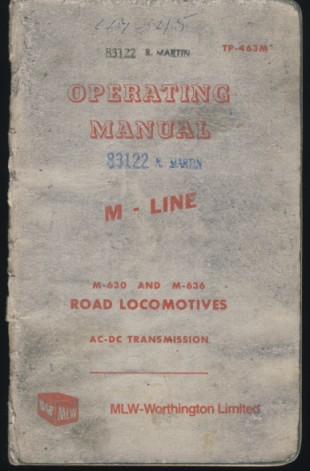
A locomotive manual which travelled thousands of miles in
Rolly's bag.
Below, the Alco-designed locomotive it helped to keep running.
Back: radiator and
cooling fan, air compressor, fluid reservoirs.
Centre: Diesel motor.
Front: electric
generator, blower ... and above: dynamic brake grids.
Below: 3400 gallons
diesel fuel.
On axles: electric
traction motors - all blown for cooling purposes.
The trainman sat in the first seat (circle) at the left of the
cab
and the former steam firemen were gone ...
having replaced retiring
enginemen.
While working as a trainman, I was therefore always the first
of the crew to arrive at our destination.
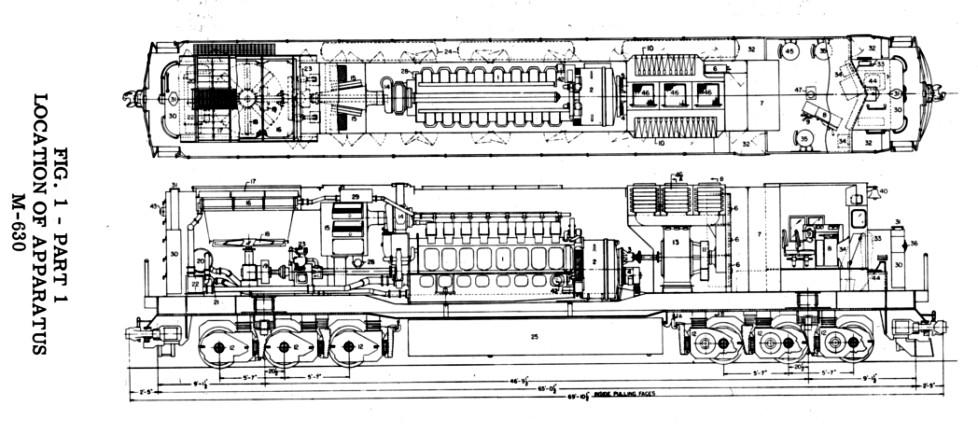
Rolly also shared his knowledge and experience with others.
In my case as a trainman, he explained the construction history
of the line along Lake Superior, pointing out the last spike
cairn. On the road, he helped me develop new skills to make me a
more professional railroader. He certainly was not afraid to
leave a nice, warm cab in a snowstorm
to show a new trainman how to effectively clean out a
snow-packed switch. Rolly spent a great deal of time and effort
training new engineers and helping them benefit from his years
of experience. Today, a number of Schreiber engineers carry on
in his tradition.
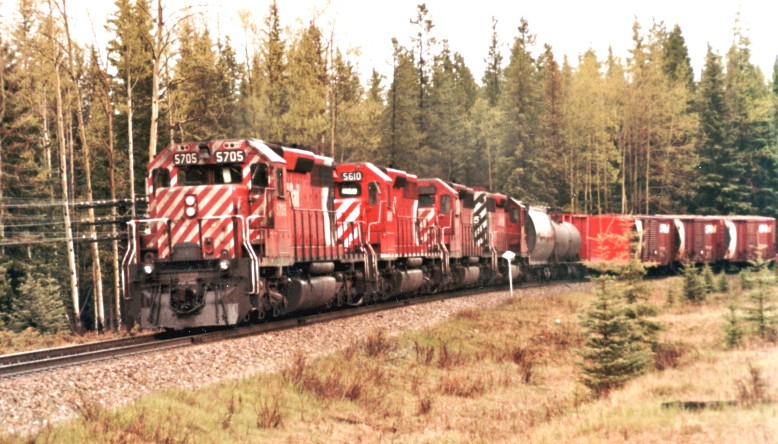
During the years I knew him, many of Rolly's locomotive consists
would
have looked exactly like this ... the 6 axle General Motors
locomotives
which were the CPR's workhorses for several decades at the end
of the
last century. As Schreiberesque as this photo appears, this
12,000
horsepower consist was photographed climbing just west of the
continental divide
in the Rocky Mountains in 1984. Once, I was talking to a CNR
hogger accustomed to bouncing
around in 4 axle GM power in the east ... he extended his arms
like The Sphinx
and said with admiration that these SDs rode like 'just like big
cats'.
At Schreiber, a very common sound was the whistle and whine of
these
locomotives' turbochargers. When starting a heavy train,
engineers
would first fiddle the throttle
back and forth between 0 and 1 for the first locomotive-length
of
travel ... to gently stretch out the slack and get the whole
train
moving. Careful modulation
around the low throttle settings continued, as sticky brakes
released
and the engineer got his first 'feel' of the train. All the
while, the turbos
would respond to each throttle setting ... by raising or
lowering their
tone at 100 decibels or so. Neither Rolly, nor any other
engineer, had any secrets from the citizens of Schreiber when it
came
to their application of tractive force as they got out of town.
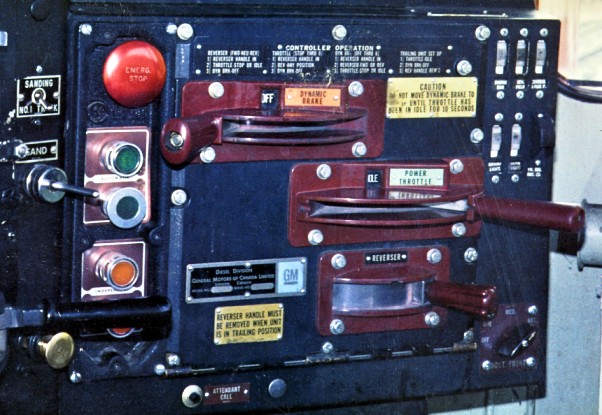 The main power controls of an EMD SD40-2.
The main power controls of an EMD SD40-2.
Running 'Number One'
Rolly ultimately rose to
become Senior Man on the Schreiber Division and spent the
last several years of his career as engineer on The Canadian
between Schreiber and Thunder Bay. In 1989, he passed the
new and
difficult CROR rules examinations (the first major rulebook
revision
since 1962) with an average in the high 90s. He qualified
for
cabooseless operations as a "Locomotive Engineer/Conductor"
in May of
1989.
On
a cool summer morning in 1987.
Rolly and mate Dave Speer will be taking Number 1 to Thunder
Bay after it is serviced at Schreiber.
About the Rules change
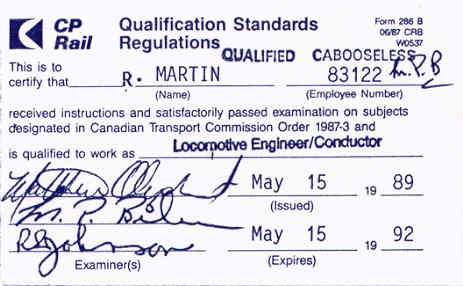
Rolly's qualifications card from passing the new Canadian
Rail Operating Rules and cabooseless procedures exams.
The previous rulebook used by federally-regulated
railways
was effective (after the 1960 elimination of steam
locomotives) in
1962.
In 1990 the new CROR rulebook became effective. At the same
time,
vans (cabooses) were eliminated and new functions, such as
monitoring
the tailend telemetry device on freight trains, were added
to the
engineer's duties. This "Sense and Braking Unit" (SBU) and
its new
monitoring computer told the engineer when the tailend was
moving,
tailend trainline air pressure status, when the tailend was
clear at a
siding, and it allowed the engineer to make an emergency
brake
application from the tailend if there was a trainline defect
such as a
crimped air hose near the headend.
In the 30 years since the end of steam, there had been
significant
changes in railway technology ... many of them due to 'main
frame'
central computerization with 'dumb terminals' - such as
teletype
machines which 'saved data to punched paper tape' -
distributed across
the railway in offices.
During the next major wave of change, 'computers'
became
small, cheap, and reliable enough to mount in
railway equipment in the field ... to regulate key functions
on
locomotives; to synthesize frequencies in radios instead of
using
crystals; to give hotbox scanners a
'voice'; to
bang
around on the last coupler of the train inside the
Sense and
Braking Unit. You could say it was the 'computer'
which spelled the end
for the conductor's van on the tailend.
Retirement
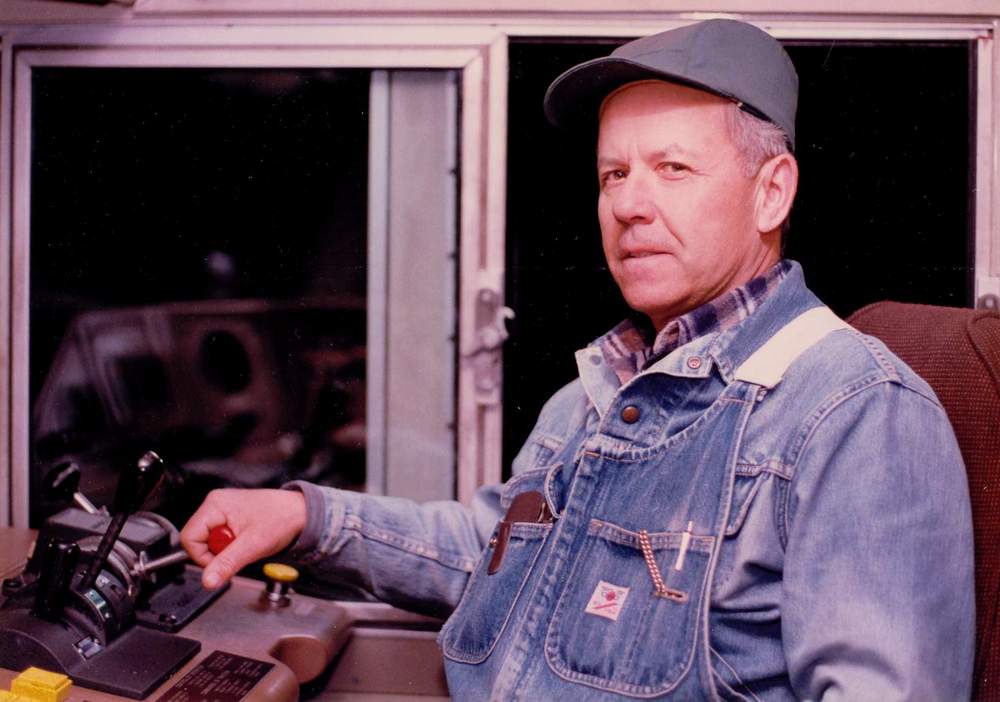
At 0330hr on December 12, 1989, Rolly brought Number 2
into Schreiber station for the last time.
It was minus 30 degrees as Rolly stepped down from the VIA
6433 into retirement.
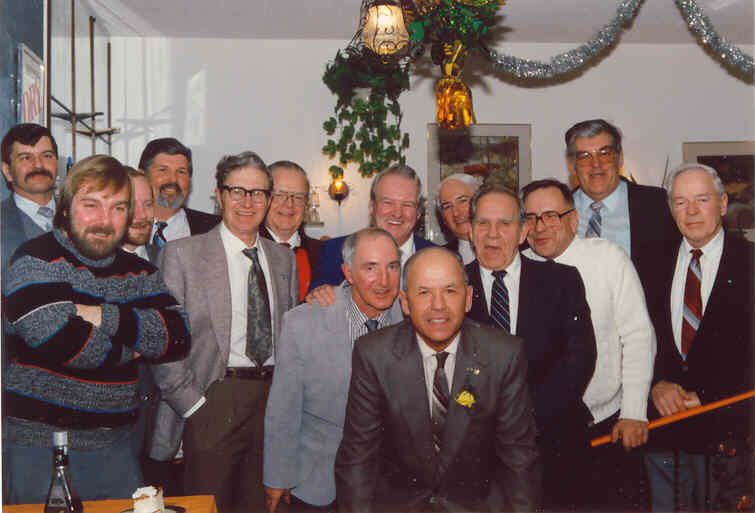
Rolly's retirement gathering in
December 1989.
Left to right: Bill Needham
retired Schreiber Terminal Supervisor, Lauri Halonen
trainman, Mike Scott diesel maintainer, David
Speer engineer and Rolly's mate on Number 1, Doc
Nesbitt retired engineer, D’Arcy McGuire
retired engineer, Jack Anderson retired conductor, Jack
Pollock conductor, Rolly Martin, Camille
Peras retired conductor, Sonny Morrow retired
conductor, Dudley Cardiff retired engineer, Bob
Krause retired engineer, Mike McGrath retired
engineer.
Rolly and Thérèse at Rolly's
retirement.
Always eager to learn
and experience new things, Rolly and Thérèse enjoyed travel,
including a cruise up the coast of Alaska and a grand Asia
Pacific tour. Of course, Rolly maintained a great interest in
the latest developments on "the road" as well.
During our visits over the years, Rolly and Thérèse did
everything with us from harbour tours of Thunder Bay, to
visiting Ouimet Canyon, to fishing expeditions with Dave Speer
for Lake Trout at Rossport, to visiting various sites of
historical interest along the shores of Lake Superior.
Through their generosity to us over
three decades, Rolly and Thérèse
made immeasurable contributions
to my "Schreiber experience".
Through this website, I
intend to keep Rolly snapping the throttle through its
notches, cycling the air,
and calling all the signals on the
Heron Bay and Nipigon Subs for years to come.
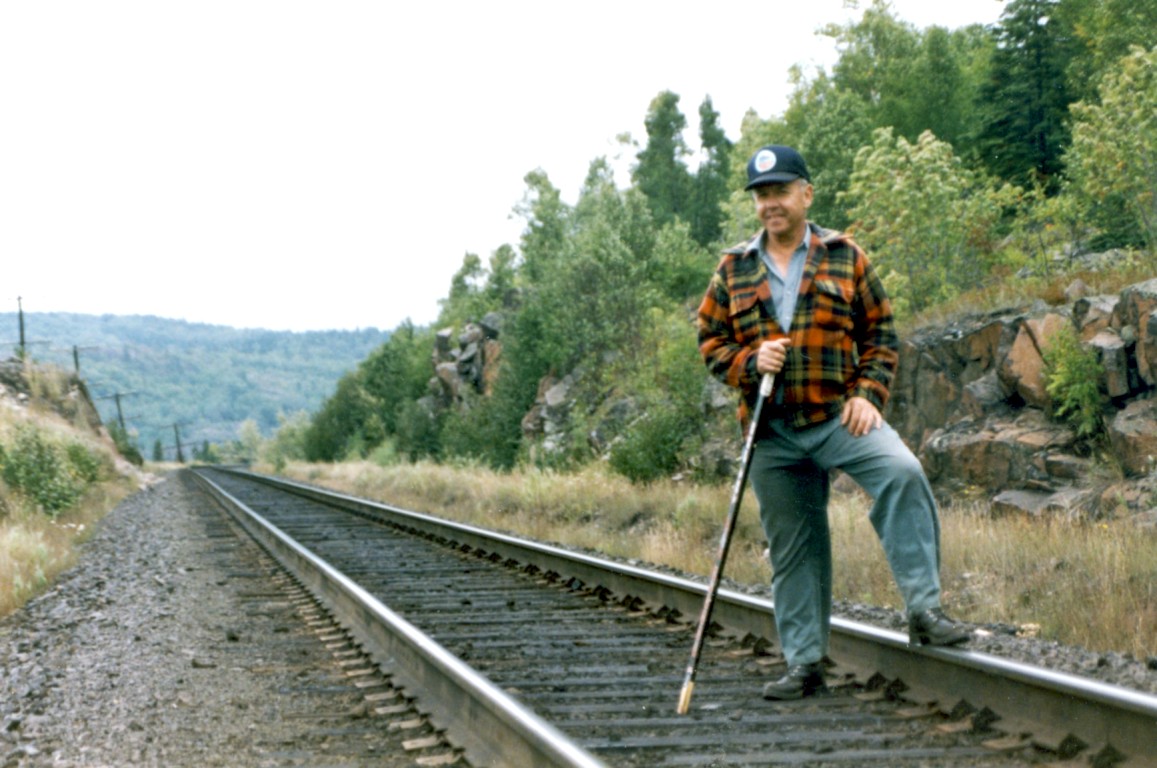
Back to
sitemap








